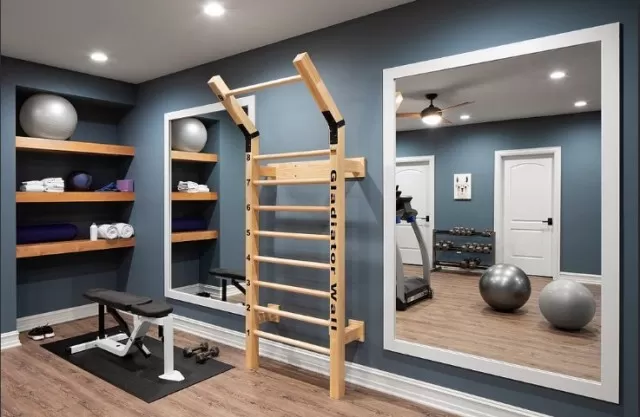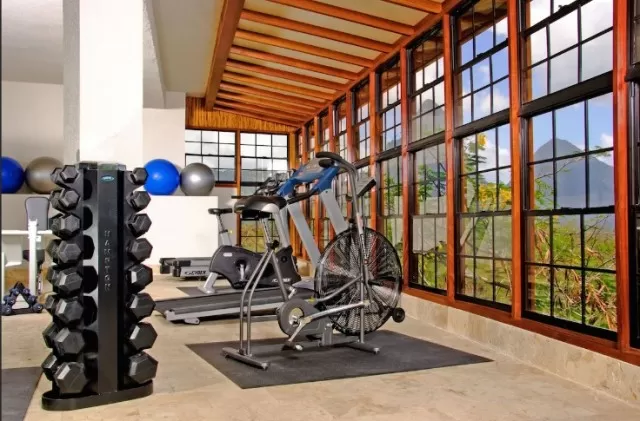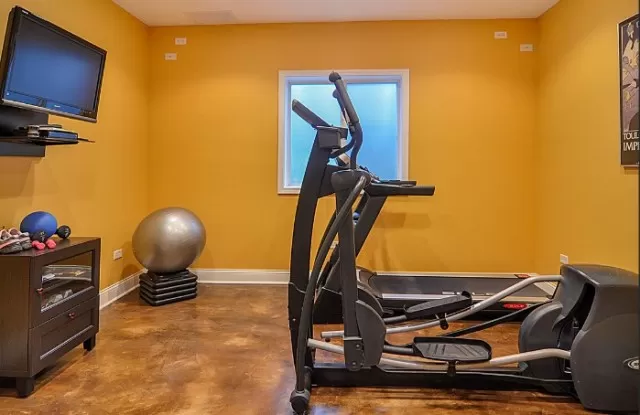Creating Your Home Gym: Designing a Personal Fitness Space. When creating a workout space at home, it’s crucial to prioritize safety and ensure that the area is structurally sound. Remember, if you have any doubts or concerns about the structural integrity or safety of your workout space, consult a professional contractor, engineer, or fitness equipment specialist for guidance and assistance.
Expanding Your Home Gym: Making the Most of Limited Space

When setting up a home gym, one crucial factor to consider is the available space.
The size, quantity, and arrangement of your fitness equipment will be influenced by the limitations of your workout area. According to the American Council on Exercise, different types of exercise equipment require varying amounts of space.
For instance, free weights necessitate around 20 to 50 square feet, treadmills require approximately 30 square feet, and a multi-station gym demands a more significant area, ranging from 50 to 200 square feet.
To optimize a smaller space, Jeff Thomsen, president of Fitness Solutions Direct in Hoboken, NJ, suggests selecting the right equipment.
Thomsen collaborates with homeowners to design gyms tailored to their available space, lifestyle, and fitness objectives. He emphasizes that certain equipment is highly functional while occupying minimal room.
Additionally, Thomsen advises choosing a square or rectangular area for your gym, as odd-shaped rooms often result in wasted space.
One ideal location for a home gym is the basement.
Architect William J. Hirsch, Jr.
, based in Cary, NC, and author of Designing Your Perfect House: Lessons from an Architect, recommends placing the gym on the lowest floor of the house to minimize noise transmission from the exercise equipment. Noise control is a critical consideration in gym design.
Treadmills, stationary bikes, and elliptical machines generate constant vibrations that can resonate through a wood-framed floor. In contrast, concrete slab floors commonly found in basements effectively absorb these vibrations.
Another advantage of basements is their naturally cooler temperature.
Architect Joshua Zinder from JZA + D in Princeton, NJ, recently completed a spacious basement renovation that included a 250-square-foot home gym.
Despite lacking windows in that specific area, Zinder aimed to create an airy and open atmosphere. He achieved this through the use of bright lighting, reflective white acoustical ceiling tiles, and strategically placed mirrors.
Zinder explains that lining the room with mirrors not only creates a sense of spaciousness but also serves the practical purpose of allowing individuals to monitor their form during workouts. Furthermore, Zinder incorporated sustainable design elements into the gym, such as using recycled materials for the ceiling tiles and rubber flooring.
Prior to the completion of their basement gym, homeowners Michael and Lori Feldstein kept their exercise equipment in their bedroom.
However, Lori expresses her satisfaction with the relocation, stating that having a designated space for exercise allows her to escape the chaos caused by her three children and indulge in some well-deserved personal time.
Attics are another popular choice for housing a home gym.
They often boast high ceilings that can accommodate tall fitness equipment and provide ample natural light, which can be particularly motivating. One drawback, however, is that vibrations from the attic gym may transfer to the rooms below.
When planning a gym in a newly constructed home or during remodeling where the floor system is accessible, Hirsch suggests installing sound-deadening insulation in the floor to mitigate noise transmission. It is also essential to insulate the walls and ceiling for soundproofing.
Fiberglass sound-deadening batts, sound-deadening drywall, or a sound-deadening board between the drywall and the studs are effective options. If you opt for an attic or upper-level gym, additional bracing may be necessary to ensure the floor can support heavy exercise equipment.
Ultimately, any space within your home, whether it’s a spare bedroom or a small alcove, can be repurposed for a gym.
Architect Joshua Zinder emphasizes the importance of creating a space that inspires and motivates you to use it regularly. Regardless of the size or location of your home gym, the key is to prioritize your fitness and dedicate a designated area that encourages your commitment to a healthy lifestyle.
Selecting the right flooring for your home gym is a crucial decision.
Gym floors are prone to perspiration drips, so it’s essential to choose a low-maintenance surface. William J. Hirsch, Jr. , suggests options such as sheet vinyl, tile, or hardwood flooring with a polyurethane finish. These choices are easy to clean and maintain. Another practical alternative is using carpet tiles, which offer resilience, sound absorption, and easy replacement. If one tile gets damaged, there’s no need to replace the entire floor.
For areas dedicated to free weights, it’s wise to consider heavy-duty mats to protect the floor.
Joshua Zinder recommends half-inch-thick recycled rubber flooring, which can be found online from specialized retailers like Rubber Flooring Inc. This type of flooring is specifically designed to withstand the impact of dropped weights.
If your gym primarily consists of machines rather than free weights, you have the flexibility to choose flooring that is more stylish and less heavy-duty.
Air Quality

Maintaining good air quality in your home gym is essential, especially during intense workouts that can lead to increased heat and humidity.
To address this, many individuals prefer to keep the gym cooler than the rest of the house. Architect William J.
Hirsch, Jr. recommends separating the heating and air conditioning system for the home gym or at least having it controlled as a separate zone off the main system.
This ensures that the temperature in other rooms of the house remains unaffected by the gym’s climate. Additionally, installing a ceiling fan can help circulate the air and contribute to a more comfortable environment in the gym space.
By taking these measures, you can create a conducive and pleasant atmosphere for your workouts while maintaining optimal air quality.
Motivational tools
In modern home gyms, televisions, DVD players, and stereo systems have become almost essential for creating an engaging workout environment.
To ensure a clutter-free and safe space, consider mounting audio-video equipment on a swiveling ceiling bracket or recessing it in a wall niche. It’s crucial to position the TV at a height that allows comfortable viewing while using elevated equipment like a stationary bicycle or an elliptical machine.
Architect Joshua Zinder emphasizes the importance of designing a gym that seamlessly integrates into your home and aligns with your personal preferences.
Aesthetics play a significant role in creating a space that you genuinely enjoy being in. By improving the finishes, aesthetics, and overall ambiance, you can transform your gym into a place where you want to spend time.
This approach will help motivate you to use the gym regularly and turn your workouts into an enjoyable experience rather than feeling like a chore.
Maximizing Your Home Gym: Optimizing Space and Design Considerations

When it comes to setting up a home gym, one of the most important aspects to consider is the available space.
The size, quantity, and arrangement of your fitness equipment will greatly depend on the limitations of your workout area. Additionally, the design and layout of your gym can have a significant impact on motivation and functionality.
This article explores various strategies and recommendations for maximizing space and creating an inspiring environment in your home gym.
*The information is for reference only.